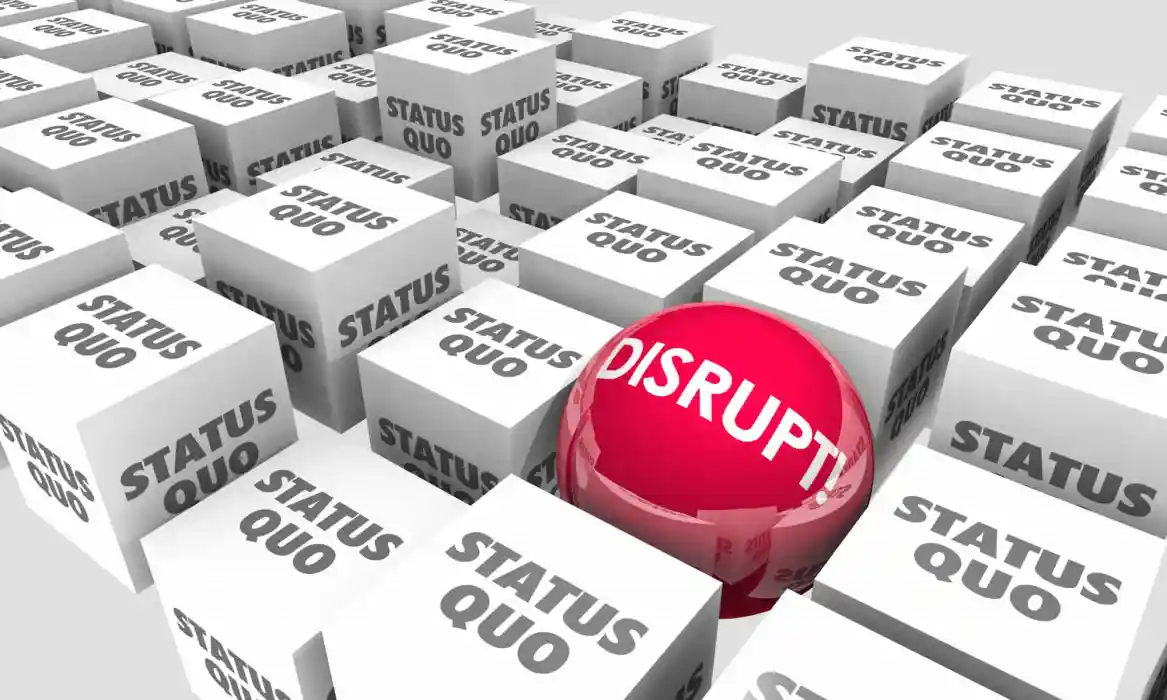5 Warning Signs of Market Disruption: Don’t Get Caught Off Guard
The business landscape is constantly evolving, and market disruptions can strike at any moment, leaving even the most established companies scrambling to catch up. One day, you’re on top of the world, and the next, a new player or innovative technology comes along and turns your entire industry on its head. The warnings signs are often there, but they can be subtle, and it’s easy to get caught up in the day-to-day operations of your business and miss them. But, ignoring these signs can be catastrophic. In this post, we’ll explore the 5 warning signs of market disruption that you need to be aware of, from shifting customer behaviors to emerging technologies that could disrupt your business model. By recognizing these signs, you’ll be able to anticipate and prepare for disruptions, rather than getting caught off guard and struggling to survive.
Introduction: Staying Ahead of the Curve
In today’s fast-paced business landscape, the only constant is change. Markets are constantly evolving, and disruptors are lurking around every corner, waiting to shake things up and leave traditional players in their dust. Think about it – who would have thought that a company like Uber would revolutionize the way we hail a taxi, or that Airbnb would turn the hospitality industry on its head? The truth is, market disruption can come from anywhere, and it’s often the companies that are most complacent in their success that are the most vulnerable to being disrupted.
As a business leader, it’s your job to stay ahead of the curve, to anticipate the changes that are coming and to position your company to not only survive but thrive in the face of disruption. But how do you do that? How do you know when disruption is looming on the horizon? The answer lies in being aware of the warning signs, the subtle changes in the market that can indicate a storm is brewing. In this post, we’ll explore the 5 warning signs of market disruption, and what you can do to stay one step ahead of the competition.
Warning Sign #1: Shifts in Consumer Behavior
The first warning sign that market disruption is looming on the horizon is a subtle yet significant shift in consumer behavior. It’s a gentle whisper that can easily be overlooked, but it’s crucial to tune in to these changes before they become a deafening roar. Perhaps your customers are suddenly seeking more sustainable and eco-friendly products, or maybe they’re prioritizing convenience and speed over traditional brand loyalty. Whatever the shift, it’s essential to recognize that it’s not just a fleeting trend, but a fundamental change in the way people interact with your industry.
Think of it like a canary in the coal mine – a small, early indicator of a larger problem. When consumers start to behave differently, it’s a sign that they’re dissatisfied with the status quo and are looking for something new, something better. If you’re not paying attention, you risk being caught off guard when a disruptor comes along and capitalizes on this unmet need. By acknowledging these shifts in consumer behavior, you can begin to adapt and innovate, staying one step ahead of the competition and ensuring your business remains relevant in a rapidly changing market.
The Rise of New Technologies: Warning Sign #2
The rapid emergence of new technologies can be a telltale sign that market disruption is on the horizon. Think about it: when was the last time you used a physical map to navigate, or listened to music on a CD? The rise of GPS navigation and music streaming services like Spotify have made these traditional methods obsolete. Similarly, the proliferation of Artificial Intelligence, Blockchain, and the Internet of Things (IoT) is transforming industries and creating new opportunities for innovation. If you’re not paying attention to these advancements, you may be caught off guard when a new technology suddenly renders your product or service obsolete. For instance, the development of electric and autonomous vehicles is poised to disrupt the entire automotive industry, from car manufacturing to insurance and transportation services. Staying ahead of the curve means monitoring the latest technological advancements and anticipating how they may impact your business. By doing so, you can proactively adapt and innovate, rather than being forced to react to a sudden shift in the market.
Changing Business Models: Warning Sign #3
The traditional business models that have been the backbone of industries for decades are being turned on their head. The rise of subscription-based services, freemium models, and pay-per-use platforms are just a few examples of how companies are rethinking the way they generate revenue. This shift is a clear warning sign that market disruption is imminent. Think about it: when was the last time you bought a CD or DVD? The music and video industries were turned upside down by the likes of Spotify and Netflix, who pioneered the subscription-based model. Today, this model is being applied to everything from car sharing to software development. If you’re still relying on traditional revenue streams, you’re vulnerable to disruption. It’s time to ask yourself: are there opportunities to rethink your business model and stay ahead of the curve? Or are you at risk of being left behind, like a relic of the past?
The Entrance of New Players: Warning Sign #4
The arrival of new players in your market can be a significant warning sign that disruption is looming. When new entrants join the fray, they often bring fresh perspectives, innovative approaches, and a willingness to shake things up. This can be particularly unsettling if they’re backed by substantial funding or have a reputation for disrupting other industries. Suddenly, your established customer base and market share are no longer a guarantee. New players may poach your top talent, lure away your customers with competitive pricing or innovative offerings, or even challenge your business model altogether. The threat is not just from traditional competitors; it can also come from unexpected sources, such as startups, technology companies, or even non-traditional players from adjacent industries. Keep a close eye on newcomers and be prepared to adapt quickly to stay ahead of the curve. Remember, it’s not just about being aware of the new players; it’s about being prepared to respond to the changes they bring to the market.
Unconventional Competition: Warning Sign #5
The fifth and final warning sign of market disruption is perhaps the most insidious: unconventional competition. This is when a new player enters the market, but not necessarily from the same industry or with a similar business model. They may not even be a traditional company, but rather a platform, a community, or even a technology that completely upends the way business is done. Unconventional competitors can come from anywhere, and their innovative approach can quickly render your traditional methods obsolete. Think of how Uber disrupted the taxi industry, or how Airbnb changed the way people travel. These new entrants didn’t just compete with existing players, they created entirely new markets and customer experiences. If you’re not constantly scanning the horizon for these unconventional competitors, you may be caught off guard and find yourself struggling to keep up. The warning signs of unconventional competition may include a sudden increase in customer acquisition costs, a shift in customer behavior, or a decline in sales despite your best efforts. If you’re seeing any of these signs, it’s time to take a step back and reassess your business model to ensure you’re not about to be disrupted by a new player that’s changing the game.
How Industries & Companies Fail to Adapt
The tale of Kodak’s demise is a cautionary one. Once the behemoth of the photography industry, Kodak’s failure to adapt to the digital revolution is a stark reminder of the consequences of complacency. In the 1970s, Kodak invented the first digital camera, but instead of embracing this innovation, they chose to ignore it, fearing it would cannibalize their lucrative film business. Meanwhile, new entrants like Sony and Canon were busy disrupting the market with their own digital offerings.
As the market shifted towards digital photography, Kodak’s sales began to decline. Despite possessing the knowledge and resources to pivot, they failed to adapt, stuck in their traditional film-based mindset. The result? Kodak filed for bankruptcy in 2012, a mere shadow of its former self.
This case study serves as a stark warning to businesses of all sizes: failure to recognize and respond to market disruptions can have devastating consequences. The writing was on the wall for Kodak, but they chose to ignore it. Don’t let your company fall victim to the same fate. Stay vigilant, stay adaptable, and always be prepared to pivot in the face of disruption.
The Cost of Ignoring Market Disruption
The cost of ignoring market disruption can be devastating. When a new player enters the market, it’s not just about a new competitor, it’s about a potential game-changer. Think of it like a tidal wave, quietly building in the distance, and then suddenly crashing down on your business, leaving destruction and disruption in its wake. If you’re not prepared, the consequences can be severe. Your market share will erode, your customers will defect, and your revenue will plummet. The worst part is that it’s not just a matter of losing a few customers, it’s about becoming irrelevant. The once-loyal customers who were the backbone of your business will suddenly find themselves drawn to the new, shiny object that’s offering them something better, faster, and cheaper. And once you lose them, it’s extremely difficult to win them back. The cost of ignoring market disruption is not just financial, it’s also reputational. Your brand, once a leader in the industry, will be seen as outdated, stagnant, and unable to adapt to changing times. The damage to your reputation can be irreparable, and it may take years to recover. Don’t get caught off guard, stay vigilant, and be prepared to adapt to the changing landscape of your market.
How to Stay Alert: Monitoring for Early Warning Signs
In today’s fast-paced business landscape, staying alert and vigilant is crucial to avoiding the devastating consequences of market disruption. The key to staying ahead of the curve is to continuously monitor for early warning signs, allowing you to adapt and respond to changes in the market before they become major threats. This means keeping a finger on the pulse of your industry, tracking trends, and analyzing data to identify potential disruptions before they escalate. By doing so, you’ll be able to anticipate and prepare for changes, rather than simply reacting to them after they’ve occurred. This proactive approach will enable you to stay one step ahead of the competition, protect your market share, and ensure the long-term sustainability of your business. By monitoring for early warning signs, you’ll be able to identify potential disruptors, such as emerging technologies, shifting customer preferences, or new market entrants, and take swift action to mitigate their impact. Don’t get caught off guard – stay alert, stay informed, and stay ahead of the curve.
Preparing for Disruption: A Proactive Approach
As the old adage goes, “forewarned is forearmed.” Rather than waiting for disruption to strike, savvy businesses can take a proactive approach to prepare for the inevitable. This means cultivating a culture of innovation, agility, and adaptability within your organization. Encourage experimentation, empower employees to think outside the box, and invest in research and development to stay ahead of the curve. By continuously scanning the horizon for emerging trends and technologies, you can identify potential disruptors before they become a threat. Develop a “what if” mindset, where you imagine scenarios in which your business model is turned upside down, and then develop strategies to mitigate those risks. By doing so, you’ll be better equipped to pivot quickly in response to changes in the market, and even turn disruption into an opportunity for growth and innovation. By being proactive, you can turn the tables on disruption and emerge stronger, more resilient, and more competitive than ever before.
Turning Disruption into Opportunity
In the midst of market disruption, it’s easy to get caught up in the chaos and uncertainty. But, what if instead of merely reacting to the changes, you could turn them into opportunities for growth and innovation? The truth is, disruption can be a catalyst for transformation, and with the right mindset, you can emerge from the turmoil stronger and more resilient than ever.
Think of disruption as a chance to re-evaluate your business model, challenge yough questions, like: “What are the underlying needs of our customers that aren’t being met?” or “How can we leverage new technologies to stay ahead of the curve?”
By embracing disruption as a catalyst for change, you can uncover new opportunities for innovation, diversification, and expansion. You can identify emerging trends and get ahead of the competition, creating new products, services, or experiences that meet the evolving needs of your customers. In short, you can turn disruption into a powerful catalyst for growth, and emerge from the storm as a leader in your industry.
Conclusion: Don’t Get Caught Off Guard
In conclusion, market disruption is an inevitable force that can strike at any moment, leaving even the most established businesses in its wake. The key to survival lies in being proactive, not reactive. By recognizing the warning signs of disruption – from shifting customer behaviors to emerging technologies – you can prepare yourself for the changes that are coming. Don’t be like the dinosaurs of the business world, stuck in your ways and unable to adapt to the evolving landscape. Instead, stay agile, stay informed, and stay ahead of the curve. Remember, disruption is not a threat, but an opportunity to innovate, to reinvent, and to rise to the top of your industry. So, stay vigilant, stay alert, and never get caught off guard. The future of your business depends on it.











About The Author
Janus Andersen
Advice on Strategy | Innovation | Transformation | Leadership Helping growth strategies and M&A transactions for 20 years